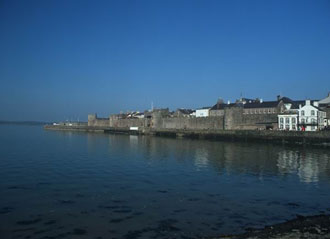可知的最早的威尔士文学要追溯到6个世纪以前,不过肯定不是在威尔士写成的。这个时候,罗马人大规模占领英国已经成为了一个遥远的记忆,日耳曼入侵者横跨全国,向西逼进。当时的地方语言,也就是威尔士语的早期形式,适用范围从英国西部到苏格兰南部,到威尔士,一直到现在的康瓦耳(Cornwall)。罗马人从来没有试图占领过爱尔兰,所以爱尔兰的相对闭塞无疑使得早期的文学能更广泛地被保留下来。而威尔士,尽管曾遭受罗马人,安格鲁撒克逊人,爱尔兰人和法国诺曼底人的入侵,还是保留下了早期文学的主干。

The earliest known literature in Welsh dates from the late sixth century, but was not necessarily written in Wales. By this date, the Roman occupation of much of Britain was a distant memory and Germanic invaders were pushing westwards across the country. The native tongue, an early form of Welsh, was in use over the western part of the country all the way from southern Scotland, through Wales to modern Cornwall. The Romans had never attempted to conquer Ireland and the relative isolation of that country no doubt accounts for the more widespread survival of early literature. Wales, despite Roman, Anglo Saxon, Irish and Norman French incursions, does have a body of early literature and an ideal introduction to this is to be found within A Pocket Guide to the Literature of Wales by Dafydd Johnston (University of Wales Press, 1994, ISBN 0-7083-1265-9). The Press also publishes Medieval Welsh Literature to c. 1400, including Arthurian Studies by Dr. Rachel Bromwich (1996, ISBN 0-7083-1376-0). This is a small but valuable booklet dealing with texts and critical studies.
Many early Welsh poems and tales are to be found within medieval collections of manuscripts which have acquired names like The Red Book of Hergest and The White Book of Rhydderch. Scholars are able to identify copies of earlier, lost works through analysis of the language. Taliesin was a late sixth century poet who was perhaps a native of north east Wales but whose poetry was in the main, devoted to the praise of Urien, the king of Rheged in north west Britain. The poems are preserved in the early fourteenth century Book of Taliesin. The king is a ferocious leader in battle but responsible for largesse and the long term protection of his followers.
Aneirin's Gododdin is believed to have been composed around the year 700 AD and is a long poem about a group of warriors who fought the invaders at a place called Catraeth, possibly modern Catterick in Yorkshire. The battle is supposed to have taken place about 600 AD and all but one of the warriors died in a hopeless battle against a much larger force. Here, the central theme is the warrior's loyalty to his lord and his readiness to fight to the death.
The Mabinogion is the title of a collection of medieval Welsh tales made by Lady Charlotte Guest in the period 1838 to 1849. The anonymous tales are found in manuscripts dating from around 1350 and some of them refer to material from a much earlier period. Dafydd Johnston: "The Four Branches (a set of stories within the Mabinogion) is arguably Wales's greatest contribution to European literature, and of all the Welsh classics it is certainly the one which loses least in translation". Rachel Bromwich notes English translations by G. and T. Jones (The Mabinogion, Everyman, 1949) and J. Ganz (The Mabinogion, Harmondsworth, 1976).
Wales's best known poet is Dafydd ap Gwilym who was active in the 1340s and 1350s. His work is translated by R. M. Loomis in Dafydd ap Gwilym the Poems (Center for Medieval and Early Renaissance Studies, State University of New York, Binghamton, New York, 1982, ISBN 0-86698-015-6). Professor Loomis provides an excellent introduction, discussing the poet, his themes and poetic techniques. Dafydd ap Gwilym is somewhat representative of a band called the Poets of the Princes because much of their work involved the composition of praise poems and elegies for princely patrons. By Dafydd's time the Welsh land-owning class had replaced the native princes as patrons and the poets would travel from one great house to another, their visits determined by important local events and religious festivals. Dafydd's family connections seem to have allowed for the development of his art. His praise poems are said to demonstrate a mastery of traditional style but he is best known for his love poems in a metrical style he is supposed to have pioneered. Many of these love poems are addressed to a lady by the name of Morfudd, the wife of a merchant.
A fascinating aspect of certain early Welsh stories lies in their references to King Arthur and members of his court. Examples are to be found in the Mabinogion. Scholarly discussions of these references are to be found in The Arthur of the Welsh edited by Rachel Bromwich, A.O.H. Jarman and Brynley F. Roberts. ( University of Wales Press, 1991-5, ISBN 0-7083-1307-8). If you just happen to be interested in the Celtic roots of the legend of King Arthur and Merlin - this is your book. It's not an easy read for most of us but is a veritable mine of detail on medieval Welsh and Latin texts and must be considered a milestone on our journey towards an understanding of early Welsh literature. Dafydd Johnston traces the demise of the professional bardic order to the end of the 17th century. The Anglicization of the Welsh gentry in the Tudor period had resulted in a dearth of patrons and heads of the great houses would often have been abroad fighting distant wars on behalf of the Crown. The Poets of the Princes were no more and a thousand year old tradition had ended.